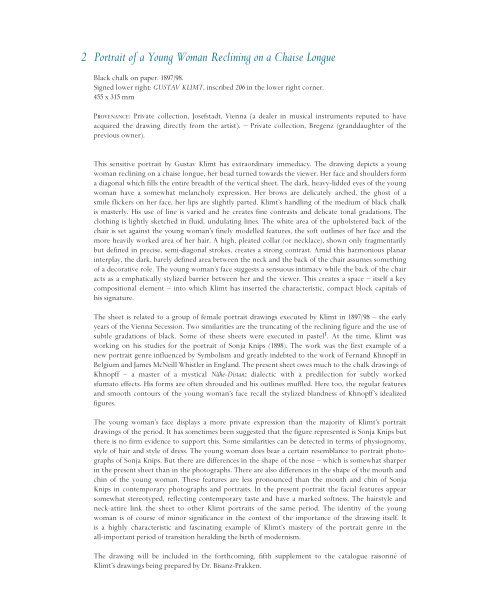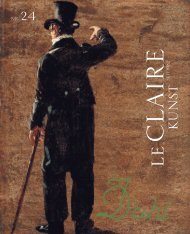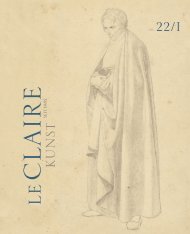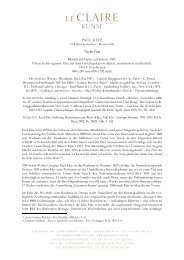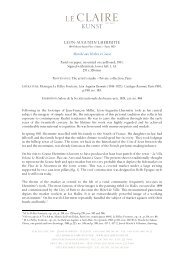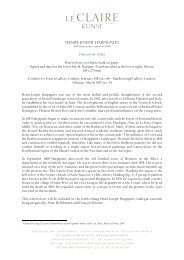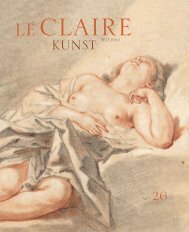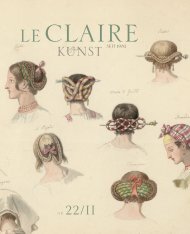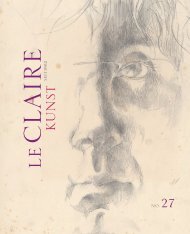Download - leclaire-kunst.de
Download - leclaire-kunst.de
Download - leclaire-kunst.de
Sie wollen auch ein ePaper? Erhöhen Sie die Reichweite Ihrer Titel.
YUMPU macht aus Druck-PDFs automatisch weboptimierte ePaper, die Google liebt.
2<br />
Portrait of a Young Woman Reclining on a Chaise Longue<br />
Black chalk on paper. 1897/98.<br />
Signed lower right: GUSTAV KLIMT, inscribed 206 in the lower right corner.<br />
455 x 315 mm<br />
Provenance: Private collection, Josefstadt, Vienna (a <strong>de</strong>aler in musical instruments reputed to have<br />
acquired the drawing directly from the artist). – Private collection, Bregenz (granddaughter of the<br />
previous owner).<br />
This sensitive portrait by Gustav Klimt has extraordinary immediacy. The drawing <strong>de</strong>picts a young<br />
woman reclining on a chaise longue, her head turned towards the viewer. Her face and shoul<strong>de</strong>rs form<br />
a diagonal which fills the entire breadth of the vertical sheet. The dark, heavy-lid<strong>de</strong>d eyes of the young<br />
woman have a somewhat melancholy expression. Her brows are <strong>de</strong>licately arched, the ghost of a<br />
smile flickers on her face, her lips are slightly parted. Klimt’s handling of the medium of black chalk<br />
is masterly. His use of line is varied and he creates fine contrasts and <strong>de</strong>licate tonal gradations. The<br />
clothing is lightly sketched in fluid, undulating lines. The white area of the upholstered back of the<br />
chair is set against the young woman’s finely mo<strong>de</strong>lled features, the soft outlines of her face and the<br />
more heavily worked area of her hair. A high, pleated collar (or necklace), shown only fragmentarily<br />
but <strong>de</strong>fined in precise, semi-diagonal strokes, creates a strong contrast. Amid this harmonious planar<br />
interplay, the dark, barely <strong>de</strong>fined area between the neck and the back of the chair assumes something<br />
of a <strong>de</strong>corative role. The young woman’s face suggests a sensuous intimacy while the back of the chair<br />
acts as a emphatically stylized barrier between her and the viewer. This creates a space – itself a key<br />
compositional element – into which Klimt has inserted the characteristic, compact block capitals of<br />
his signature.<br />
The sheet is related to a group of female portrait drawings executed by Klimt in 1897/98 – the early<br />
years of the Vienna Secession. Two similarities are the truncating of the reclining figure and the use of<br />
subtle gradations of black. Some of these sheets were executed in pastel 1 . At the time, Klimt was<br />
working on his studies for the portrait of Sonja Knips (1898). The work was the first example of a<br />
new portrait genre influenced by Symbolism and greatly in<strong>de</strong>bted to the work of Fernand Khnopff in<br />
Belgium and James McNeill Whistler in England. The present sheet owes much to the chalk drawings of<br />
Khnopff – a master of a mystical Nähe-Distanz dialectic with a predilection for subtly worked<br />
sfumato effects. His forms are often shrou<strong>de</strong>d and his outlines muffled. Here too, the regular features<br />
and smooth contours of the young woman’s face recall the stylized blandness of Khnopff’s i<strong>de</strong>alized<br />
figures.<br />
The young woman’s face displays a more private expression than the majority of Klimt’s portrait<br />
drawings of the period. It has sometimes been suggested that the figure represented is Sonja Knips but<br />
there is no firm evi<strong>de</strong>nce to support this. Some similarities can be <strong>de</strong>tected in terms of physiognomy,<br />
style of hair and style of dress. The young woman does bear a certain resemblance to portrait photographs<br />
of Sonja Knips. But there are differences in the shape of the nose – which is somewhat sharper<br />
in the present sheet than in the photographs. There are also differences in the shape of the mouth and<br />
chin of the young woman. These features are less pronounced than the mouth and chin of Sonja<br />
Knips in contemporary photographs and portraits. In the present portrait the facial features appear<br />
somewhat stereotyped, reflecting contemporary taste and have a marked softness. The hairstyle and<br />
neck-attire link the sheet to other Klimt portraits of the same period. The i<strong>de</strong>ntity of the young<br />
woman is of course of minor significance in the context of the importance of the drawing itself. It<br />
is a highly characteristic and fascinating example of Klimt’s mastery of the portrait genre in the<br />
all-important period of transition heralding the birth of mo<strong>de</strong>rnism.<br />
The drawing will be inclu<strong>de</strong>d in the forthcoming, fifth supplement to the catalogue raisonné of<br />
Klimt’s drawings being prepared by Dr. Bisanz-Prakken.


